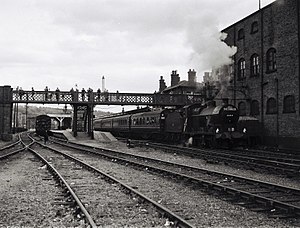Luton Bute Street railway station
Luton Bute Street | |
|---|---|
 4F 0-6-0 44414 heads The Cobbler special out of Luton Bute Street railway station to Dunstable, Leighton Buzzard and Northampton. 19 September 1964 | |
| General information | |
| Location | Luton England |
| Platforms | 3 |
| Other information | |
| Status | Disused |
| History | |
| Original company | Hertford, Luton & Dunstable Railway |
| Pre-grouping | Great Northern Railway |
| Post-grouping | London and North Eastern Railway |
| Key dates | |
| 3 May 1858 | Opened as Luton |
| 25 September 1950 | Name changed to Luton Bute Street |
| 26 April 1965 | Closed[1] |
Railways around Luton | ||||||||||||||||||||||||||||||||||||||||||||||||||||||||||||||||||||||||||||||||||||||||||||||||||
|---|---|---|---|---|---|---|---|---|---|---|---|---|---|---|---|---|---|---|---|---|---|---|---|---|---|---|---|---|---|---|---|---|---|---|---|---|---|---|---|---|---|---|---|---|---|---|---|---|---|---|---|---|---|---|---|---|---|---|---|---|---|---|---|---|---|---|---|---|---|---|---|---|---|---|---|---|---|---|---|---|---|---|---|---|---|---|---|---|---|---|---|---|---|---|---|---|---|---|
| ||||||||||||||||||||||||||||||||||||||||||||||||||||||||||||||||||||||||||||||||||||||||||||||||||
Luton Bute Street railway station was the first to be built in Luton, England. It was opened by the Luton, Dunstable and Welwyn Junction Railway Company in 1858, which was an extension of the Welwyn and Hertford Railway. The track to Welwyn was completed in 1860 and taken over by the Great Northern the following year.
History
The station was valuable to Luton people not only for passengers but also for facilitating the London market for the town's trade in plaited straw goods. The station, and the line to Welwyn, closed in 1965.[2]
Following closure to passengers in 1965, the station buildings were quickly demolished despite the line remaining open for freight until 1989–1990. The site of the station was used later as a car park for Luton railway station. Throughout the years, various local pressure groups have been supportive of reopening the station as part of a viable branch line between Dunstable and Luton. In the mid-1990s, there was a debate about reopening it, either with the operation of diesel Class 158s or electric Class 319s.[citation needed]
The site has since been redeveloped, as the new Luton Gateway transport interchange on the Luton to Dunstable Busway guided busway system.
Routes
| Preceding station | Disused railways | Following station | ||
|---|---|---|---|---|
| Chaul End Line and station closed |
Great Northern Railway Dunstable Branch Line |
Luton Hoo Line and station closed |
See also
References
- ^ Quick, M E (2002). Railway passenger stations in England, Scotland and Wales – a chronology. Richmond: Railway and Canal Historical Society. p. 281. OCLC 931112387.
- ^ Radford, B., (1983) Midland Line Memories: a Pictorial History of the Midland Railway Main Line Between London (St Pancras) & Derby London: Bloomsbury Books
External links
51°52′54″N 0°24′50″W / 51.8817°N 0.4139°W
